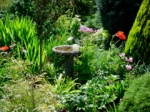With apologies to Jane Garmey, editor of The Writer in the Garden, an anthology of garden-related literature. I read many works about gardens and gardening, and enjoy some more than others. Among my favorites: Jenny Uglow’s light hand at heavy subjects (A Little History of British Gardening tops my list), Christopher Lloyd’s acerbic wit and Ursula Buchan brisk style.
Writers are told that what they read will influence what they write. It isn’t only garden writers I look to, but good writing in general, in the hope of getting an idea across in an entertaining, insightful and knowledgeable manner without wasting a word. I’m irritated when reading a book and find myself editing it for style, syntax and word choice. Some books, both fiction and nonfiction, start with a great idea and they may be full of interesting elements, but overall the writing is thin at best. Naturally, I always wonder how in the world these books get in print.
 If I’m to try my best at writing about the gardens we visit — be it the famous Hidcote Manor or a private garden open through the National Garden Scheme — then I need to surround myself with good writing. Without even trying, I came up with three writers who excel at their craft:
If I’m to try my best at writing about the gardens we visit — be it the famous Hidcote Manor or a private garden open through the National Garden Scheme — then I need to surround myself with good writing. Without even trying, I came up with three writers who excel at their craft:
Jo Rowling — I don’t write fiction, but if I did I would want to write dialogue like she does. No wasted words anywhere, and every turn of phrase evokes time, place and character.
Erik Larson — I’m just finishing Thunderstruck. He’s precise in his research, and careful about not interpreting past events through modern eyes. It’s true, I did have to skim over the details of the murder, just as I had to skim over a few paragraphs in Devil in the White City, but I admire him for his unsentimental (and unsensational) approach, while holding my interest through all the details.
Ray Bradbury — A deep thanks to the master. I do not write science fiction or fantasy, but I will be forever grateful to Ray Bradbury, his imagination, and his enthusiasm for writing and for others who write. I’ve attended four of his talks, the first when I was in 7th grade (more than 40 years ago), the last just a few years ago. He’s an inspiration.



